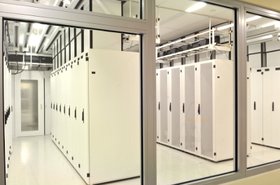Because firmware is an essential part of data center operations it needs to be on a solid maintenance schedule. As the basis for your server’s input/output (I/O), performance and power management, a server’s firmware has direct impact on your infrastructure’s performance, reliability, security, and efficiency. Like Botox, without regular maintenance the effects are lost. In the following article, I’ll not only look at why firmware updates area critical, but why as a practice, it’s only the tip of the iceberg when it comes to better performance.
Firmware refers to the small fixed programs and data structures used to control electronic devices, such as servers. Original equipment manufacturers (OEMs) typically ship servers with the latest firmware version. Over the product cycle, firmware versions may change to improve performance, fix vulnerabilities or add functionalities on the same server model. This means that the same model server shipped at a different time in the life cycle may have a different firmware version. Moreover, OEMs push firmware updates on a regular basis until the point when a server reaches End of life (EOL).
Not all out-of-the-box server firmware versions are the same
With limited or no control over the initial firmware version received on a server, data centers often end up with a variety of different firmware versions for the same server model. While seemingly insignificant and possibly more than just a hassle, disparate firmware versions across your data center infrastructure management platform could cause a variety of issues that may be hard to detect or easy to overlook as an ongoing aspect of server health maintenance.
When a data center consistently updates server, it will immediately notice improved server health (thermal), performance, security and general reliability. In contrast, the presence of differing firmware versions may result in less than optimal or low performance across your facility. The solution is to maintain the most recent firmware for all devices.
A key challenge and reason why most IT administrators may miss firmware updates is how cumbersome the process is. Updating firmware across your data center environment is time consuming and inefficient, especially when performed manually, across hundreds of servers. Further complicating the matter is that device drivers may need to be downloaded and updated after the actual firmware update. This adds an additional step in the process, slowing down the implementation and increasing the potential for error, which could cause further delays. In simple terms, the methodologies used to manually update server firmware are outdated and unsustainable.
Automated data center device management improves cost efficiency
With technology advancements, improvements to this manual process should also be considered. Data centers may manage servers that span across national boundary lines. As a result, the enterprise needs a way to simplify this process by removing complexity; easily and remotely identifying server firmware versions; quickly identifying outliers; and conveniently updating the firmware of specific server models with minimal effort and downtime. Automated tools provide the solution to improving outcomes and increasing efficiency, saving time by eliminating the need for costly travel to perform menial tasks. By providing insight into the variety of firmware versions deployed across your servers, the process can be simplified and tracked more efficiently.
Automated data center management tools with the capability to produce outliers’ reports allow data centers to identify the devices that need to be updated. This automated discovery feature helps IT managers ensure their environment is up to date. Management tools must be device-neutral, and provide at-a-glance firmware status reports. Decision makers should opt for solutions that allow operators to schedule and track updates while maintaining a history of versions for trend analysis year over year.
Remotely processed server batches drive further efficiency in data centers
To improve overall outcomes and drive business efficiency, data centers should be automated and controlled from remote locations by management tools. Without visibility into specific device metrics in real-time, decision makers often have to solve problems based on assumptions.
Without automated tools, efficiency becomes difficult, especially with the growing number of devices deployed in today’s enterprise data center operations. Reliance on manual processes makes efficiency difficult. Data center management tools will allow operators to schedule batch updates during off peak hours to ensure overall efficiency while reducing and even eliminating downtime. By eliminating tedious repetitive tasks, management allows staff to focus on high impact, high frequency tasks that require human intervention.
Firmware updates are important, but only the tip of the iceberg
When a data center operation deploys a management solution to expedite firmware updates it eliminates the need of physically going to servers one-by-one, or using expensive KVM hardware to do the same thing from a remote location. Steps must be handled one server at a time and can be prone to delays and errors. Neither of these options are efficient, they’re equally expensive, and can impact uptime, especially when there’s a better way.
Automated tools allow international companies to maintain efficiency while removing complexity. With the remote access control, batching and scheduling, and outlier reports, datacenter operations can substantially eliminate manual processes while maintaining current firmware versions over massive numbers of multiple OEM devices. The process is sustainable and eliminates the potential for human error.
Though important for optimal functioning, the benefit of automated data center management tools goes well beyond simplifying the task of firmware updates. Data centers can implement solutions that monitor power and thermal data in real-time requiring no manual intervention. This automated cross-platform visibility provides the tools IT teams need to track the energy consumption of individual servers and racks, presenting a holistic view of data center operations.
Adopting a data center management tool can be a surprisingly easy first step toward better performance. Automated efficiency, especially when you have solid experts helping you navigate the process, is not difficult and the potential savings might surprise you.





